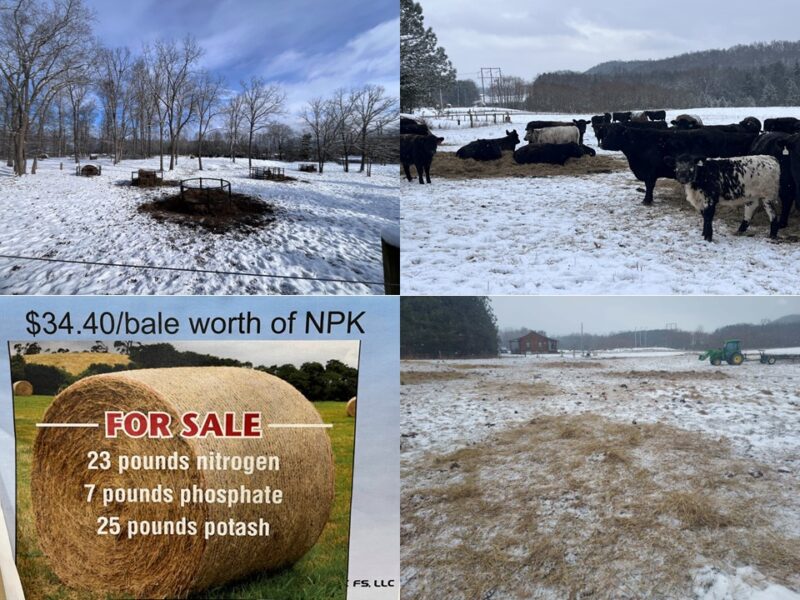Punxsutawney Phil said we would still be in the snow as you read this. If you’re like me, feeding animals in the “Perpetual November” northeast narrative has taken a pause around here with locals welcoming frozen concrete and an old-fashioned winter of snow and cold.
This has given way to many livestock farms considering or using some sort of winter feeding strategy out on the land instead of in a barn with all the labor, cleanup and maintenance costs. It’s where bale-grazing is gaining traction in the regenerative toolbox as a fertility bomb, labor saver, and fresh air housing tool.
My bale grazing mentor, farmer and University of Kentucky agricultural economics professor, Greg Halich, says, don’t let the challenges of bale grazing in the east region scare you from using this winter-feeding technique. It can be done by learning a few fundamental concepts and adapting it to your farm. https://agecon.ca.uky.edu/5-commandments-bale-grazing-east
The bale grazing context is placing static bales in a planned tic-tac-toe framework out on pasture and fed to animals in a controlled manner (hay ringed or not), somewhat like rotational grazing, allocating fresh feed every 1 to 7 days using portable fencing, in most cases. Depending on fertility and animal performance needs, soil structure, topography, available shelter, water access, machinery access and labor goals, fields are “stocked” with big round bales to meet these objectives, typically recommended at 2 tons (4-5x5s’) per acre to minimize long term field damage.
It’s well documented that hay fed on fields (pasture or crop) using a livestock component improves fertility to the tune of $50/ton of hay, (Chris Teutsch, Univ of Kentucky), plus the urine and organic matter captured. This fertility transfer is associated, in many farming circles, as “waste”.
Bale Grazing Pioneer and Canadian Rancher, Steve Kenyon, says we must find comfort in what is left behind. He routinely talks about the real waste as being mostly stems and not the higher quality parts of the plant. He also points to the savings in yardage costs and not starting a tractor everyday as significant savings. The practice savings can be as diverse as any farm.
Bale grazing isn’t an all or nothing tool. There are many ways farmers are using this strategy depending on their specific goals. Some place bales in rows for a particular timeframe like a week’s vacation to someplace warm, some turn animals into a set paddock without portable fences, some place bale bombs to thwart undesirable plant proliferation, and depending on weather and other factors, they may choose to feed high quality baleage or big square bales instead. It’s a very versatile practice with endless opportunities for all hay eaters.
The versatility of these modern wrapped bales are also being rolled out in long feeding strips with an abundant array of homemade or industry made unrollers which many farmers like using, to spread nutrients and animals out. I’m particularly fond of gravity feeding, whereby I pre-place bales at the top of a hill and “give’em a shove”, so my ruminate manure spreaders can do what equipment can’t. Folks are using all types of self-feeders but the key is to keep them moving and use hay feeding to target fertility deficiencies.
The bale grazing context doesn’t need to be just a winter activity. It can be used on land to save grass during a drought, supply supplemental feed in cover crop grazing or crop residues, extend stockpiled grazing reserves or providing an area for weaning or other animal husbandry needs.
Angus Glen Farm owner and 2024 Region 1 Environmental Stewardship Award recipient, Brett Chedzoy, says to have a strategic plan, observe your animals, watch the weather forecast, adapt your management and have fun. He emphasizes nutrient management, convenience (can lay out weeks of hay in advance when time and ground conditions allow) and animal welfare as his “three big reasons for bale grazing”.
If you feel like using this practice, there are thousands of on-line resources to guide you and farmers in your neck of the woods to go visit and see if it’s a tool that could work for you. Remember, “The mind that opens up to a new idea never returns to its original size.”


 Mittens: The Devine Thread
Mittens: The Devine Thread »
»